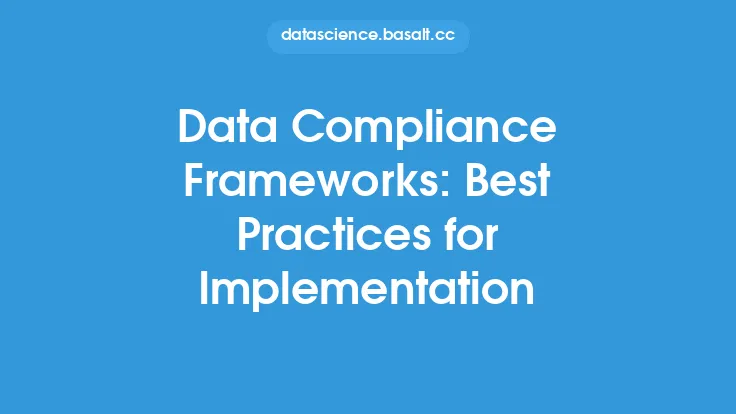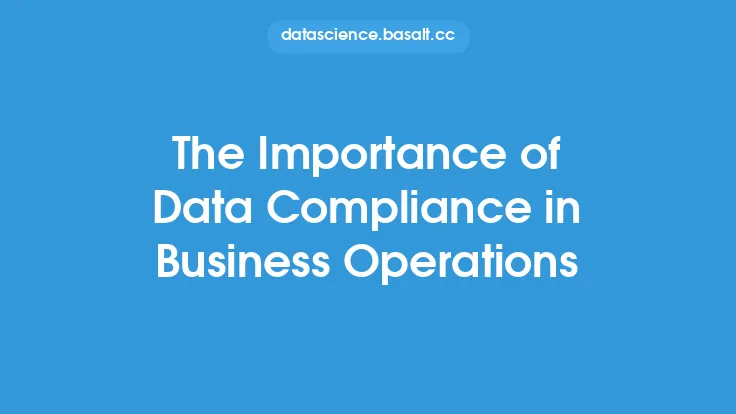In today's digital landscape, organizations handle vast amounts of sensitive data, making data compliance a critical aspect of their operations. As a result, it's essential for employees to understand the importance of data compliance and how to handle sensitive information effectively. Data compliance training is a vital component of any organization's data governance strategy, as it empowers employees to make informed decisions and take appropriate actions to ensure the confidentiality, integrity, and availability of sensitive data.
Introduction to Data Compliance Training
Data compliance training is designed to educate employees on the laws, regulations, and industry standards that govern the handling of sensitive data. This type of training helps employees understand their roles and responsibilities in maintaining data compliance and provides them with the knowledge and skills necessary to identify and mitigate potential risks. Effective data compliance training programs should be tailored to the specific needs of the organization and its employees, taking into account the types of data handled, the industry, and the relevant laws and regulations.
Key Components of Data Compliance Training
A comprehensive data compliance training program should include several key components, such as:
- Overview of relevant laws and regulations, including the General Data Protection Regulation (GDPR), the Health Insurance Portability and Accountability Act (HIPAA), and the Payment Card Industry Data Security Standard (PCI DSS)
- Data classification and handling procedures, including guidelines for sensitive, confidential, and public data
- Data security best practices, including password management, encryption, and access controls
- Incident response and breach notification procedures, including steps to take in the event of a data breach
- Consequences of non-compliance, including fines, penalties, and reputational damage
- Employee responsibilities and expectations, including reporting requirements and confidentiality agreements
Benefits of Data Compliance Training
Data compliance training offers numerous benefits to organizations, including:
- Reduced risk of data breaches and non-compliance, resulting in lower fines and penalties
- Improved employee awareness and understanding of data compliance requirements, leading to better decision-making and risk mitigation
- Enhanced reputation and public trust, resulting from a demonstrated commitment to data protection and compliance
- Increased efficiency and productivity, as employees are better equipped to handle sensitive data and respond to incidents
- Improved compliance with regulatory requirements, reducing the risk of audits and enforcement actions
Best Practices for Implementing Data Compliance Training
To implement effective data compliance training, organizations should follow best practices, such as:
- Conducting regular training sessions, including annual refresher courses and new employee onboarding programs
- Using interactive and engaging training methods, including online modules, workshops, and role-playing exercises
- Providing ongoing support and resources, including access to subject matter experts and compliance resources
- Monitoring and evaluating employee understanding and compliance, using metrics such as quiz scores and incident response times
- Continuously updating and refining training programs, to reflect changes in laws, regulations, and industry standards
Technical Aspects of Data Compliance Training
From a technical perspective, data compliance training should cover topics such as:
- Data encryption and decryption methods, including symmetric and asymmetric encryption
- Access control mechanisms, including role-based access control (RBAC) and attribute-based access control (ABAC)
- Data loss prevention (DLP) techniques, including data classification and monitoring
- Incident response and breach notification tools, including security information and event management (SIEM) systems
- Compliance management platforms, including governance, risk, and compliance (GRC) software
Measuring the Effectiveness of Data Compliance Training
To measure the effectiveness of data compliance training, organizations should track key metrics, such as:
- Employee participation and engagement, including training completion rates and quiz scores
- Incident response and breach notification times, including the time taken to respond to and contain incidents
- Compliance audit results, including findings and recommendations
- Employee feedback and suggestions, including surveys and focus groups
- Return on investment (ROI), including cost savings and revenue growth resulting from improved compliance and reduced risk
Conclusion
Data compliance training is a critical component of any organization's data governance strategy, as it empowers employees to make informed decisions and take appropriate actions to ensure the confidentiality, integrity, and availability of sensitive data. By providing comprehensive and ongoing training, organizations can reduce the risk of data breaches and non-compliance, improve employee awareness and understanding, and enhance their reputation and public trust. As the digital landscape continues to evolve, it's essential for organizations to prioritize data compliance training and stay up-to-date with the latest laws, regulations, and industry standards.





